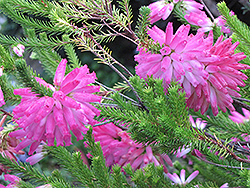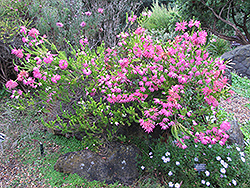It's all about ...
plants

Height: 5 feet
Spread: 3 feet
Sunlight:
![]()
Hardiness Zone: 9a
Other Names: Marsh Heath, Cape Flats Heath
Description:
A very attractive, strong shrub, featuring rose-pink tubular flowers arranged in whorls near the upright branch tips; requires organic, slightly acidic soil, full sun and excellent drainage; prune when young to increase bushiness, and flower bearing stems
Ornamental Features
Whorl Heath features showy clusters of rose tubular flowers with pink overtones at the ends of the branches from mid spring to mid fall. It has green evergreen foliage. The tiny needles remain green throughout the winter.
Landscape Attributes
Whorl Heath is a multi-stemmed evergreen shrub with a mounded form. It lends an extremely fine and delicate texture to the landscape composition which can make it a great accent feature on this basis alone.
This is a relatively low maintenance shrub, and should only be pruned after flowering to avoid removing any of the current season's flowers. It is a good choice for attracting bees to your yard. It has no significant negative characteristics.
Whorl Heath is recommended for the following landscape applications;
- Accent
- Mass Planting
- Hedges/Screening
- General Garden Use
Planting & Growing
Whorl Heath will grow to be about 5 feet tall at maturity, with a spread of 3 feet. It has a low canopy with a typical clearance of 1 foot from the ground, and is suitable for planting under power lines. It grows at a slow rate, and under ideal conditions can be expected to live for approximately 20 years.
This shrub should only be grown in full sunlight. It does best in average to evenly moist conditions, but will not tolerate standing water. It is very fussy about its soil conditions and must have rich, acidic soils to ensure success, and is subject to chlorosis (yellowing) of the foliage in alkaline soils. It is somewhat tolerant of urban pollution. Consider applying a thick mulch around the root zone in winter to protect it in exposed locations or colder microclimates. This species is not originally from North America.
This plant is not reliably hardy in our region, and certain restrictions may apply; contact the store for more information.


